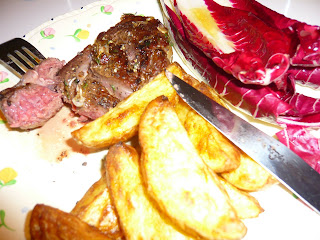
This is comp week for the big investment banks, where the rich get filthy and the merely comfortable get an extra pillow to prop against their back. Or as my cousin, who works for a non-revenue-generating division of the Great Satan, puts it:" tomorrow is the day when my lamentably un-obscene, non-Daily-Mail enraging bonus is announced ."
This time of the year, stories designed to get the common man het up circulate in the papers, such as that of the BarCap traders who lunched to the tune of 44,000 ocean going squid back in 2002, guzzling Ch. Petrus and foie gras with grim abandon.
In the minted world of the beautifully becoiffed, excess usually entails covering expensive stuff in gold leaf, or stuffing your second most expensive ingredient into your most expensive one. Elsewhere, back in the real world, a celebratory banquet is marked by multiple dishes, or the use of many ingredients: a wedding biryani, a royal tajine, or a roast baron of beef with all the trimmings.
This salad is a celebration of contrasts: chewy, pillowy, crunchy, and flavours: tart, sweet, earthy.
Mebos again. I love this ingredient. They have a wonderful sweet/sour flavour due to the pickling process they undergo. When cooked, they melt and soften into the dish and impart an agreeable tanginess.
Warm chickpea, butternut, mushroom and mebos saladEnough for 4 people. We ate this with some roast chicken thighs that had been marinated in garlic, lemon, olive oil, a splash of white wine, red onion, sumac and ground allspice. Dried apricots can be substituted for mebos: allow 1 handful in this recipe.
In the morning, soak a heaped cup of chickpeas in enough water to cover generously. Allow 1 ½ hours to cook: place in a small lidded saucepan covered with 2cm fresh, unsalted water. Boil rapidly for 10 minutes, and then turn the heat down to a simmer, covered. Check every now and then to ensure they don't cook dry. Taste for doneness after 90 minutes – they may need longer. Once they have finished cooking, drain the water and toss with 1 tsp olive oil and a small splash of white wine if you have anything open. Add a grind of salt and leave lidded until needed.
Whilst you're waiting for your chicks to hatch, peel and de-seed a medium sized butternut and chop into 2cm cubes. Toss with olive oil,1 tsp thyme and seasoning and cook in an oven preheated to 180°C until the cubes have coloured and softened, around 25 minutes.
Whilst you're waiting for your butt, sweat 1 leek, sliced into ½cm rounds,in a non-stick frying pan over medium heat in a little olive oil until they are softened. Don't allow them to colour, please. Remove the leeks and set aside. Now (without adding any more oil), turn the heat to medium low and add 250g sliced brown mushrooms. Cook slowly, turning every now and then, until the mushrooms darken and give up their juice. Turn the heat up a touch, add the leeks, a good sprinkle of chilli flakes, 2 finely chopped mebos, a handful of toasted hazelnuts (dry fry until they start to colour and smell nutty, then allow to cool a little and rub together in your big hairy paws to remove some of the skins, before chopping them in half) a little chicken stock or wine to loosten, and seasoning. Add the chickpeas and butternut and a handful of something green: rocket, baby spinach, sorrel or watercress. Allow to wilt slightly, and remove from the pan into a serving dish.
Lastly, make a little vinaigrette: 1 tsp dijon mustard, 1 tsp honey, 1 tbl olive oil, and a little water (I had orange blossom water to hand). Stir well to emulsify and then stir into the salad. Taste for seasoning, and be generous with the black pepper.
Did I say lastly? What an incorrigible tease. Fry a small handful of fresh sage leaves in a little vegetable oil until crisp. Scatter over the salad just before serving.







